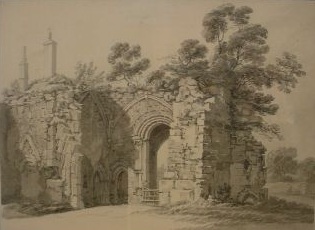THE MONK'S GRAVE.
The remains of the priory at Kenilworth adjoin the parish church. The burial-ground has been lately enlarged, and several graves discovered. One was opened, in order to observe the mode of interment, and closed again immediately. The ruins of the castle are about half a mile distant.
Four hundred years ago they buried thee.
While fitful fragments of the vesper hymn
Rose from within the cloistered sanctuary,
And by red torch light in thy chamber dim
Thy narrow death-nook, in white cowl and trim.
They left thee to the slumbers of decay;
Then turning, with chill heart and tottering limb.
In reverend silence sought their cells, to pray
Each for his own, all for thy resurrection day.
It was an iron age, they say, and cold.
Full of stern men, harsh words, and desperate deeds,
When thou wert hidden in this crumbling mould:
On yon grey towers, besprent with listless weeds.
Whereon dusk ivy and the dank grass feeds.
As on a battlemented skeleton.
The thoughtful eye a deeper meaning reads
A gorgeous tale of pride and glory gone,
And strength and hopes decayed since thou wert left alone!
High pageant in old Kenelworde! High beat
A thousand hearts; while stately banners hung
In glossy folds, and tread of busy feet
Through hollow archway and tall bastion rung,
Green Avon's leafy labyrinths among;
And here the solemn chant of saintly men,
Who in the light-stained chancel knelt and sung.
Far heard amid thy deep'ning woods, Arden,
Floated 'twixt earth and heaven, till lost in air again.
A dream long since departed! —a brave chant,
Whose echoes died and fainted long ago:
Still o'er those old grey towers the moist rays slant
Of an autumnal sun, and wild and low
Through creaking trees and beckoning branches flow
The mournful sobbings of the evening gale—
Earth's everlasting penitent! Below,
Through the thick gathering shades the black rooks sail,
And the hoarse owlet tells his melancholy tale!
Yet sleep'st thou not alone: the kindred dead
Of Christian generations round thee lie.
Each in his sacred cell to silence wed.
The dust of perishing mortality.
Unchanged to us, as were to them and thee.
The deep-toned church bell and the daily prayer,
Increasing in their gentle power, float by
From day to day, from year to withering year,
Of an immortal life a promise sweet and fair.
We leave thee here again—yet not alone;
The streams of old that gurgled in thine ear,
Man's pageant past away—these are not gone.
Not wholly lost in time and silence drear.
The wind's sweet force—the sunlight warm and clear—
The green corn rustling on the breezy hill.
These are to us as they to thee were dear.
Strong in their quiet mystery to fill
The troublous heart with love, and calm the struggling will.

The following poem and description is from a very old book.
Kenilworth Priory was built about the year of Our Lord 1124. It flourished to the point of being named St. Mary's Abbey.
However it was dismantled as part of the Dissolution of the Monasteries (when the monasteries and convents in England and the lands of the Church were confiscated, and monks and sisters cast out) in 1538. It is now in ruins.
As the monks and nuns are souls purely dedicated to God, when they are faithful, their prayers are the most efficacious for the salvation of souls and protection of a people. With the dissolution of the monasteries, the consequences for England, were beyond belief. These confiscations have happened throughout the nations in recent history, but due to other great evils too there have been huge losses of consecrated souls very recently, and this is a part of and a sign of terrible catastrophes and chastisements still to come.
And so the picture of the ruins of Kenilworth has deep meaning for the future.

 Saints' Discussion Forums
Saints' Discussion Forums












 Saints' Discussion Forums
Saints' Discussion Forums










